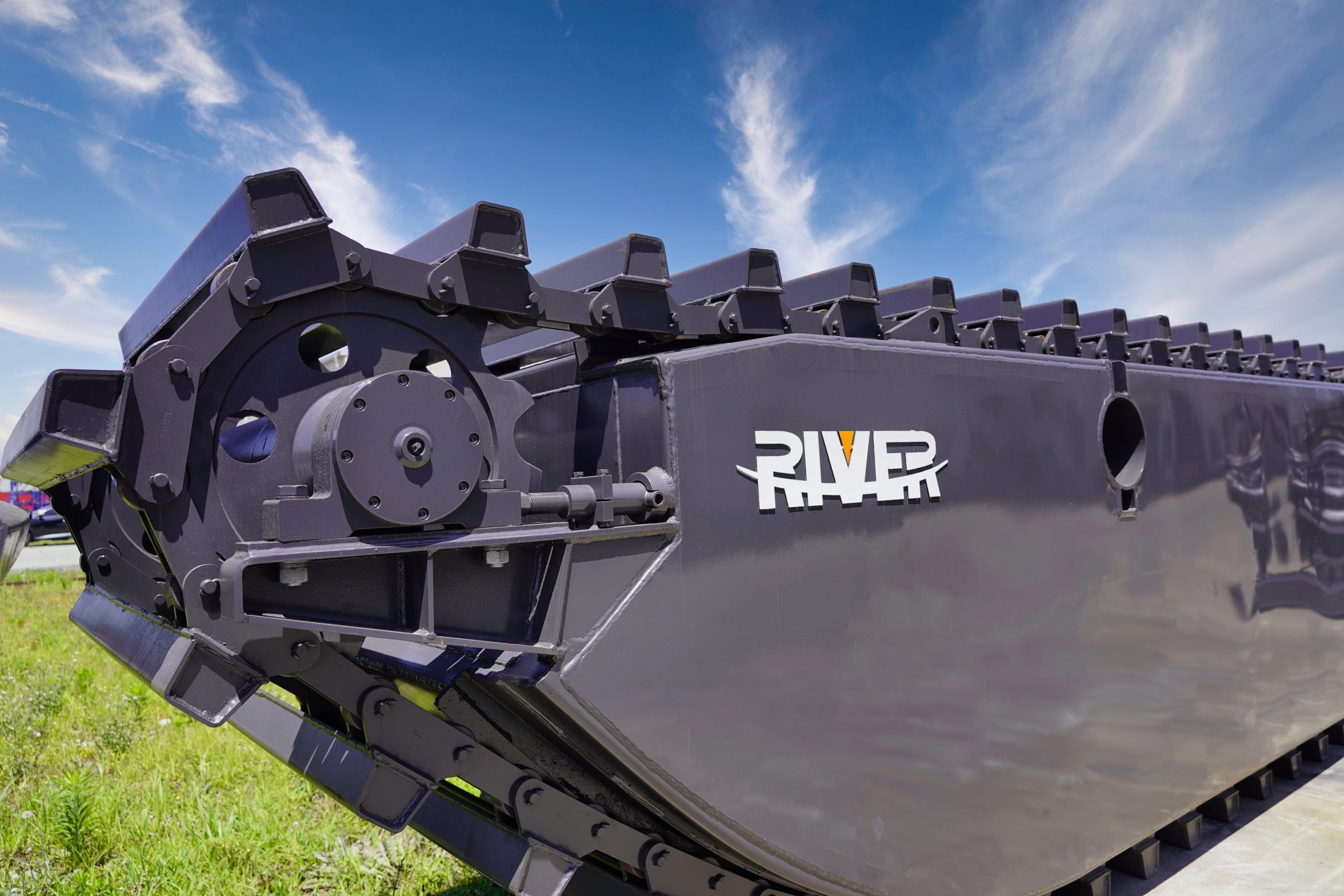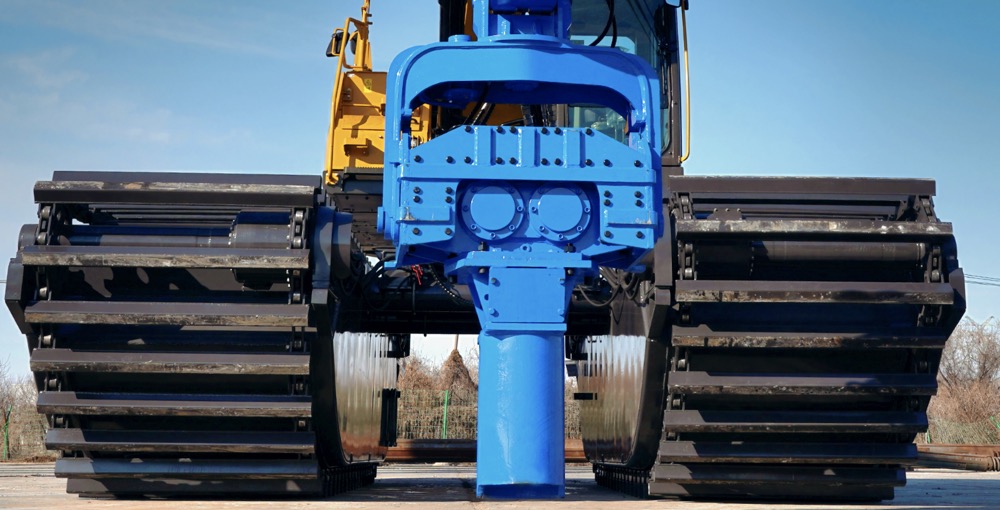1. Why Should You Maintain the Pontoon Undercarriage Like Caring for Your “Legs and Feet”?
The amphibious undercarriage chains and track shoes of an amphibious excavator are like a person’s legs—they must bear the weight of tens of tons while also wading through mud and water and climbing steep slopes. If something goes wrong with them:
- Minor Issues: Chain breakage halts operations, costing thousands daily.
- Major Risks: Deformed track shoes may cause machine tilting, increasing rollover risks in swamps.

River Heavy Industry’s Pontoon Undercarriage Advantages:
- Armor-Grade Protection: Chains use 40Cr heat-treated material (3x more wear-resistant than standard). Track shoes employ HG785 high-strength steel (high durability, low thermal expansion).
- Modular Design: Replace damaged sections instead of the entire undercarriage, saving time and costs.
2. Structure & Materials of Track Assembly: The Explanation & Analysis of Core Technologies
Design of Track Chain Structure:
Triple-Component Design: Pins, bushings, and rollers made of 40Cr heat-treated steel for high load resistance and wear performance.

Track Shoe Reinforcement Technology:
Material: HG785 high-strength steel with surface heat treatment for enhanced tensile strength.
Structural Design: Internal vertical ribs improve stability. Welded connections between track shoes and chains ensure robust load-bearing capacity.

3. Common Fault Diagnosis & Analysis of Track Chains
Chain Failures:
| Symptom | Root Cause | Potential Risk |
|---|---|---|
| Uneven wear on one side | Misaligned guide rollers or tension | Machine deviation, accelerated sprocket wear |
| Seized pins | Lack of lubrication or seal failure | Increased chain breakage risk |
| Broken links | Overload, shock loads, metal fatigue | Machine instability; urgent shutdown required |
Track Shoe Failures:
| Symptom | Root Cause | Emergency Action |
|---|---|---|
| Loose bolts | Insufficient preload or neglect | Tighten immediately; check thread integrity |
| Edge curling | Impact or lateral stress | Replace damaged shoe; adjust route |
| Coating peeling | Chemical corrosion or abrasion | Apply anti-corrosion coating promptly |
4. Pre-Maintenance Preparation: 3 Tools + 4 Safety Rules
Toolkit Checklist:
| Tool | Purpose | Alternative |
|---|---|---|
| High-pressure washer | Remove mud from chain gaps | Hose + brush |
| Caliper | Measure chain elongation | Coin test (detailed later) |
| Waterproof grease | Lubrication & rust prevention | Use OEM-specified grease only |
Safety Rules (Critical!):
Engage parking brake: Use wheel chocks on slopes.
Wear goggles: Prevent debris injuries during washing.
No open flames: Grease is flammable; avoid welding zones.
Teamwork: Two-person coordination during adjustments.
5. Chain Maintenance in 3 Steps: Clean, Lubricate, Adjust
Step 1: Deep Cleaning (10 mins):
Use a high-pressure washer to flush mud from chain joints.
Self-check: Insert a coin into the chain teeth. If it wobbles 3mm, replace the chain.
Step 2: Proper Lubrication:
Use River Heavy Industry LC-3 Waterproof Grease (red packaging) until oil beads form.
Avoid WD-40: It offers temporary rust prevention but strips grease.
Step 3: Tension Adjustment:
Standard: 3-5 chain links should sag on the track.
Adjustment rule: “Loosen front, tighten rear” based on sprocket position.
Replace entire chains after 3,000 operating hours.
6. Track Shoe Maintenance: Check Deformation, Prevent Rust
Deformation Check:
Park the excavator on flat ground. Move 1 meter forward/backward.
Normal: Uniform track shoe imprints.
Abnormal: Uneven width (lateral bending) or wavy imprints (twisting).
Rust Prevention:
Process: Rinse → Spray WD-40 Specialist Corrosion Inhibitor → Wipe dry.
Replace track shoes every 4,000 hours to avoid downtime.
7. Maintenance Tips for Harsh Environments
Scenario 1: Seawater Operations:
Rinse chains with freshwater daily to prevent salt crystallization.
Weekly inspect pins for green corrosion (indicates copper alloy damage).
Scenario 2: Swamp Work:
Apply a thin cement slurry to chains pre-operation (dries and sheds mud).
Scenario 3: Monsoon Season:
Double lubrication frequency (biweekly instead of monthly).
8. Professional Maintenance Ensures Long-Term Value
RIVER Heavy Industry’s “Full Lifecycle Service” philosophy guarantees OEM parts, technical support, and optimized maintenance plans. Clients following this guide achieve:
Extended undercarriage overhaul cycles (4,000–8,000+ hours) 42% annual maintenance cost reduction.
Contact River Heavy Industry for customized solutions!
